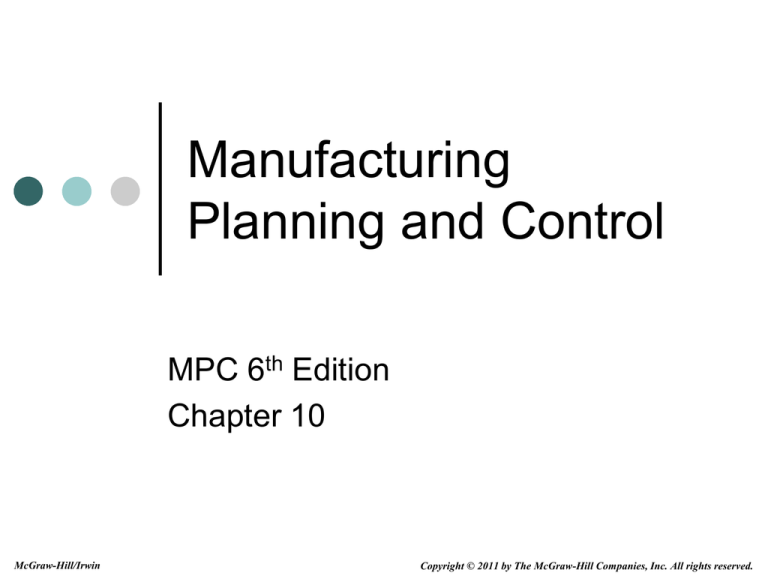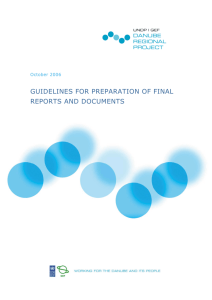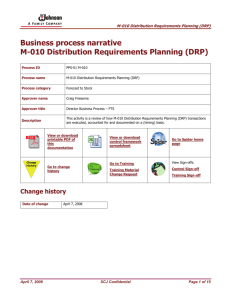
Manufacturing
Planning and Control
MPC 6th Edition
Chapter 10
McGraw-Hill/Irwin
Copyright © 2011 by The McGraw-Hill Companies, Inc. All rights reserved.
Distribution Requirements
Planning
Distribution requirements planning (DRP)
provides the basis for integrating supply
chain inventory information and physical
distribution activities with the manufacturing
planning and control (MPC) system.
10-2
Agenda
DRP in the Supply Chain
DRP Techniques
DRP Management Issues
Principles
10-3
DRP in the Supply Chain
DRP links firms in the supply chain
Planning records carry demand information from
receiving points to supply points and returns
supply information to the receiving points
DRP integrates key linkages in the supply
network
DRP can be linked to the MPC systems of the
manufacturer, customers, and suppliers
Spans the boundary from internal to external
MPC
10-4
DRP Links to MPC
DRP Links
10-5
DRP Role
DRP coordinates material flows through the
physical distribution system
Effectively managing the flow of goods and
inventories between the firm and the market
Planned timings and quantities for
replenishing inventories throughout the
physical distribution system
Provides information to the master scheduler
in a format consistent with MRP records
10-6
DRP and the Marketplace
DRP starts at or near the marketplace
Local demand data can help manage field
inventories
Special orders
Planned inventory adjustments by customers
10-7
DRP and Demand
Management
DRP information is
key to developing
logistics system
management plans
10-8
DRP and Master Production
Scheduling
DRP allows incorporation of records and
information into the MPS system
Extends MPC visibility into the distribution
system
Can have political costs
Boundaries between supply chain partners
Convincing them of the value of integration
DRP collects detailed information in the field,
summarizes it, and passes it along to the
MPC system
10-9
DRP Techniques
Basic DRP
Record
TimeLinking
Managing
Phased
Warehouse Day-to-Day
Order Point Records
Variations
Safety
Stock
10-10
Basic DRP Records
Records are maintained centrally as part of
the MPC system
Records are kept for stockkeeping units
(SKU)
Extends the bill of materials to define the
SKU as an SKU in the field warehouse
Product isn’t “completed” until it has been
delivered to the location where it satisfies
customer demand
10-11
“In transit” goods
can’t easily be
expedited or
delayed
DRP Record
Forecast includes
information on
special orders and
customer inventory
adjustments
Period
On hand 1
Forecast requirements
20
In transit
Projected available balance
2
3
4
5
20
20
20
30
45
25
55
60
45
Planned shipments
25
65
60
60
Safety stock = 20,
shipping quantity = 60, lead time = 2
10-12
Time-Phased Order Point
Time-phased order point (TPOP) uses
forecast information for requirements and a
time-phased MRP approach to develop
planned shipments
TPOP record shows planned shipment data
All demand sources (TPOP, service parts,
interplant shipments) are considered by the
DRP system
10-13
Linking Several Warehouse
Records
Information about
planned requirements
from all field
warehouses is passed
along to the central
facility
Implosion–process of
bringing demand
information back to
the central facility
10-14
Managing Variations from
Plan
One method for dealing with errors is to stabilize
the information flow
Firm planned orders–reduce variation by
reviewing implications of change before allowing
changes to occur
Error addback method–assumes forecasts are
unbiased
• Shortages from one period are predicted to be madeup in the next (or excess sales are believed to result in
reductions in the future)
• Less effective if the forecast is biased
10-15
Safety Stock
DRP allows carrying of safety stock at any
location in the system
Safety lead time is also an option
More frequent replenishment reduces the
necessary safety stock
Useful when delivery times are variable
Aggregating uncertainty from several
locations allows safety stock reductions
Risk pooling
10-16
DRP Management Issues
Data Integrity
Organizational
and
Support
Completeness
Problem
Solving
10-17
Data Integrity and
Completeness
Garbage-in, garbage-out
Use of aggregate forecasts, which are then
broken down into detailed forecasts
Errors can increase as total is disaggregated
Forecast adjustments must be made carefully
to avoid introducing systematic bias
Forecast adjustments should be monitored
Inventory accuracy requires efficient, accurate
transaction processing
10-18
Organizational Support
Objectives must consider inherent conflicts
among functional groups
10-19
Problem Solving
Changing conditions cause uncertainty in the
system
Demand
Changing market conditions
Changing product lines
Changes to marketing plans
DRP records can anticipate these changes
and minimize their impact
10-20
Principles
Top-level DRP records should cover items in a location as
close to the customer as possible.
Local information and demand patterns should be
incorporated into the DRP record at a warehouse and/or
the customers’ MPC data should be used at customer
locations.
Data and performance measurement systems should be
put in place to monitor forecast adjustments in the field.
Matching supply to demand requires close control of supply
as well as data on demand.
10-21
Principles
Projections of future requirements should be used to decide
inventory allocation in periods of short supply.
Transparent records and consistent processing logic should
be used to integrate the system.
What-if analysis should be based on integrated records of the
system.
Uncertainty filters, like firm planned orders or error addback,
should be available to the master production scheduler.
The organization form should be consistent with the supply
chain being managed.
10-22
Quiz – Chapter 10
A major tool in DRP systems is the ____________
record.
Customer purchases are generally part of
_________ demand.
The time-phased order point (TPOP) approach uses
what type of data to determine requirements?
DRP systems can utilize both safety stock and
safety lead time? (True/False)
10-23












